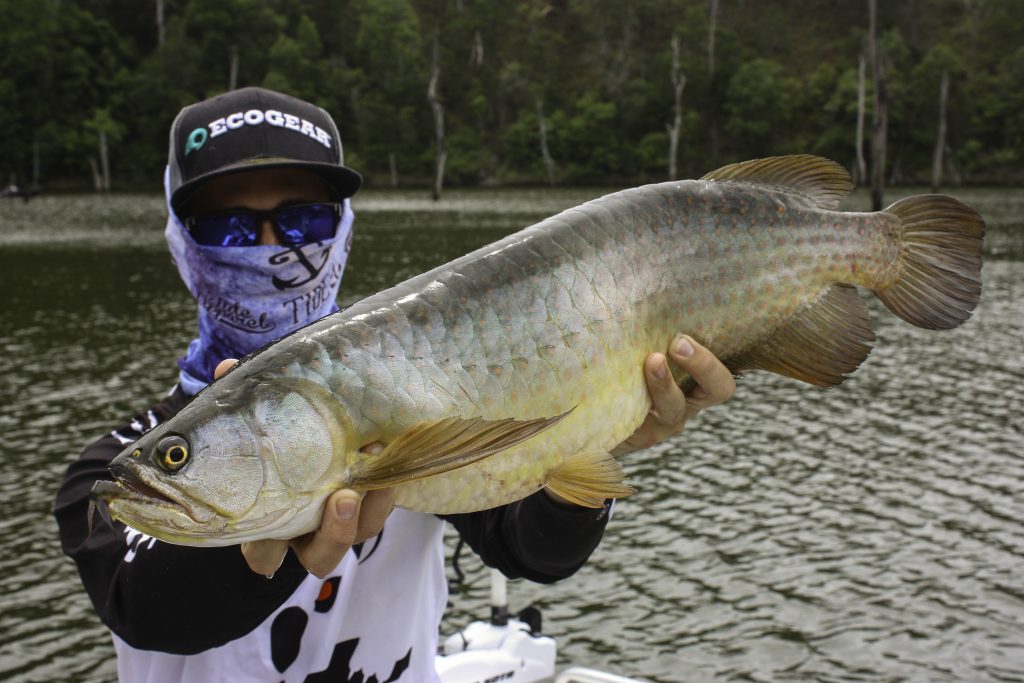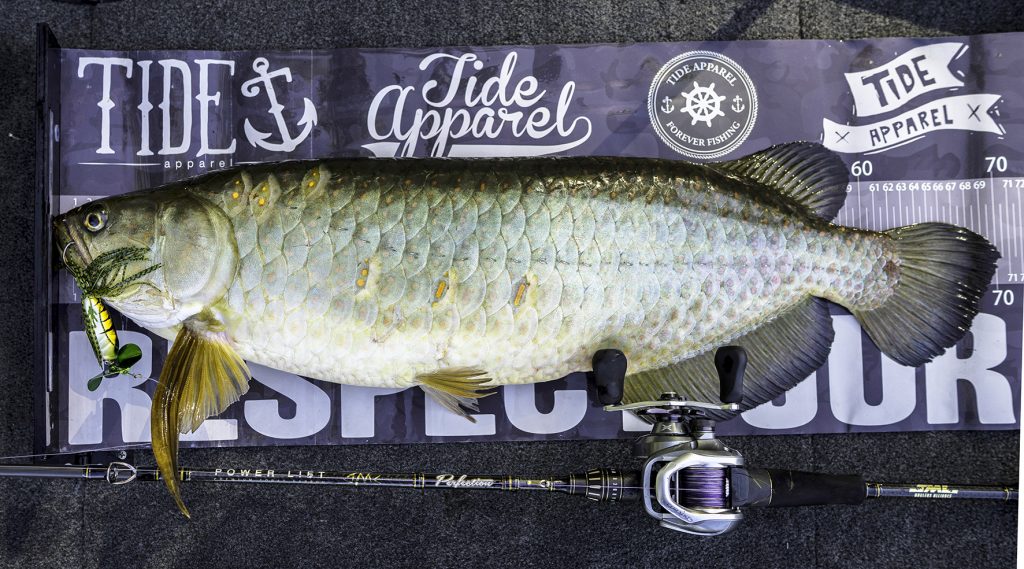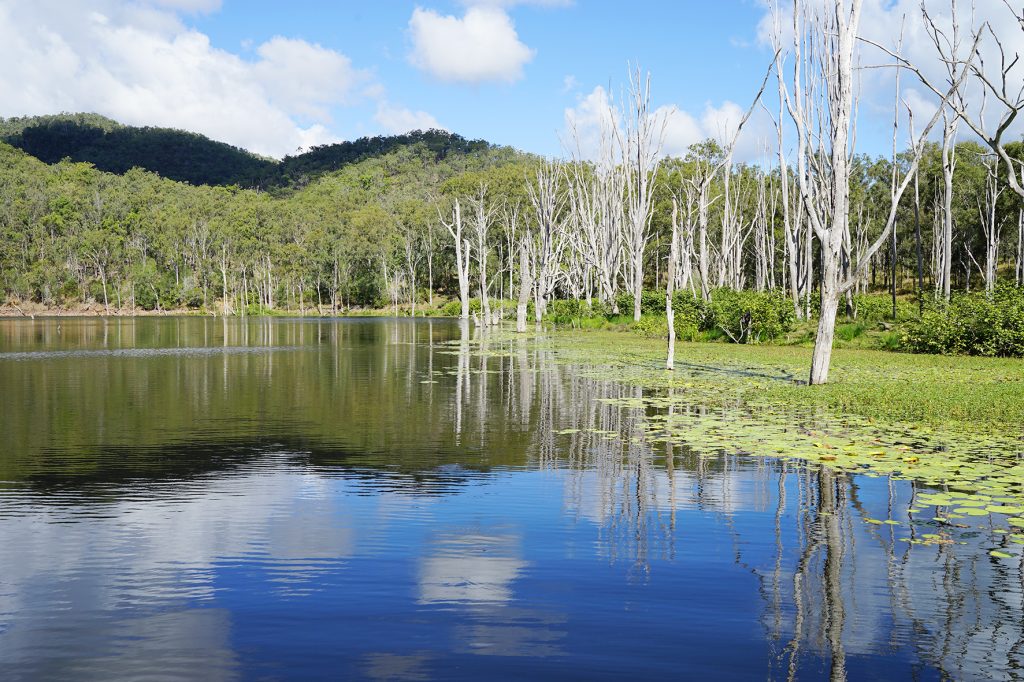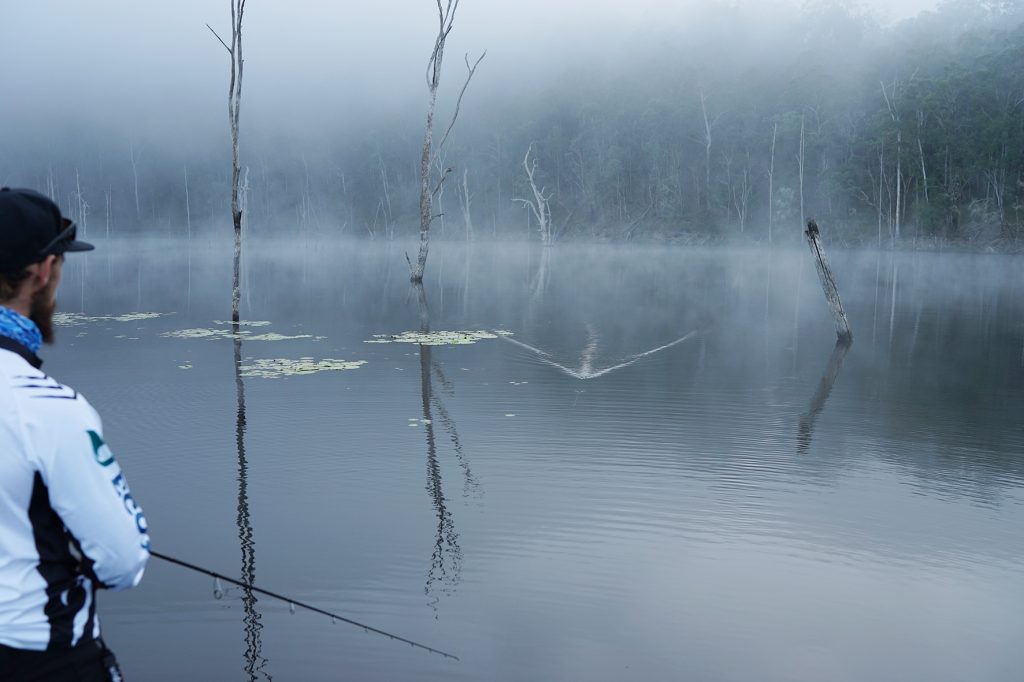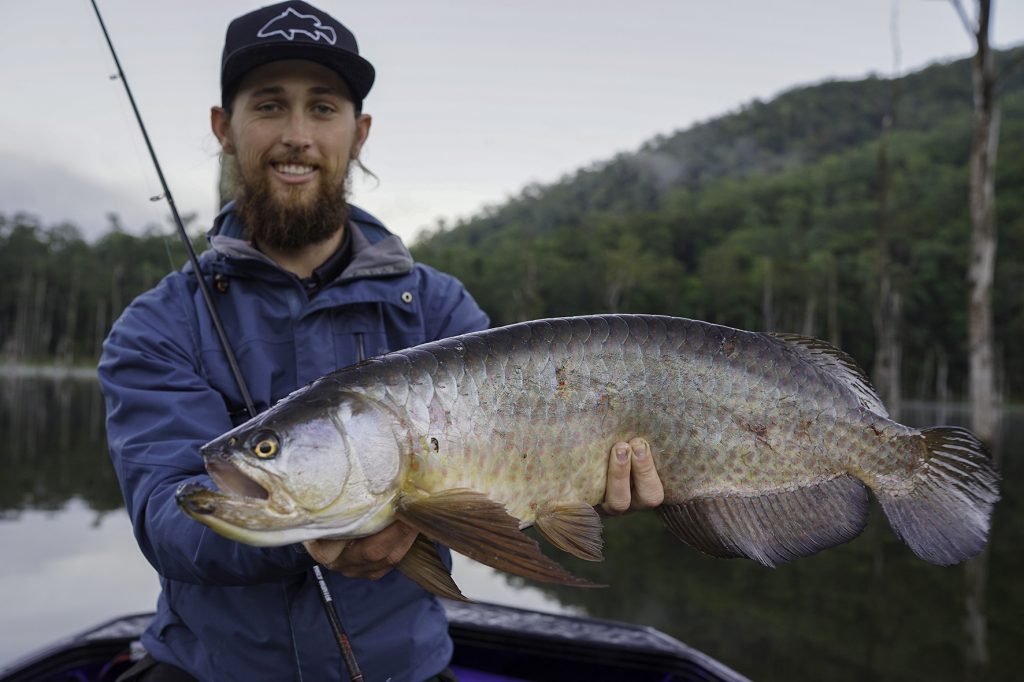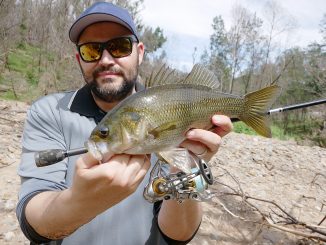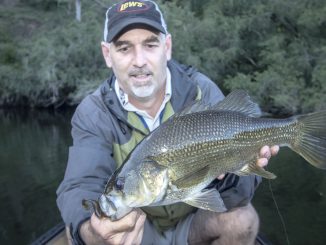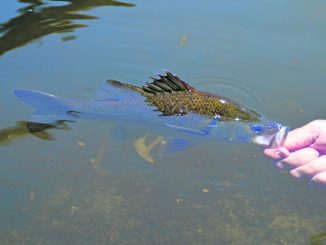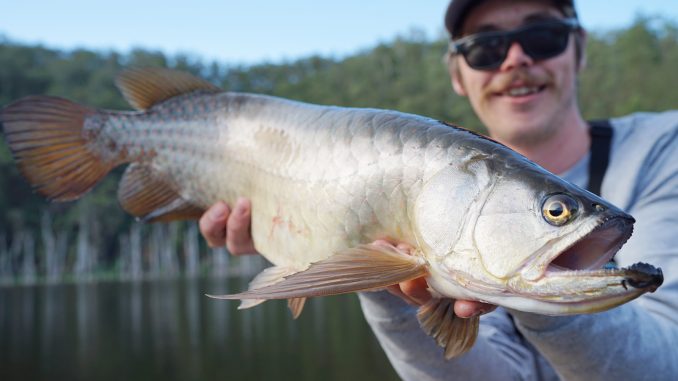
by Chris Lindsay •
Picturesque Lake Borumba is located in the Wide Bay–Burnett region of Queensland and is roughly 170km north of Brisbane’s CBD. Its primary purpose is to provide water to the Mary Valley irrigation scheme, but it’s also used for recreational purposes such as fishing, skiing and kayaking. Lake Borumba has been stocked with Australian bass, silver perch, golden perch and saratoga in the past.
As you may know, most of our Australian native species will not breed or reproduce in our impoundments, and this is mostly due to their not being able to follow their natural migration patterns. For example, during winter bass need to be able to migrate downstream into their spawning grounds in saltwater estuaries to breed. Weirs, dams and floodgates prevent the bass from doing this.
Saratoga, however, can happily breed in impoundments and lakes.
Borumba’s toga
The initial stocking numbers of saratoga in Lake Borumba were small, but these fish have been able to maintain a self-sustaining population within the lake. Over the years they have been recorded in increasing numbers.
Saratoga are a beautiful prehistoric-looking fish that have had very little study conducted on them compared to our other native species. Saratoga are a great sporting species, with exploding surface strikes and acrobatic leaps – what’s not to like about them!
Saratoga generally spend most of the time roaming around in the top 20% of the water column. Their eyes are on the top of their head and they have a streamlined body that makes them the perfect predator. Saratoga can grow up to around 90cm and have even been rumoured to reach 1m in length, but are more commonly caught between 40cm-75cm in Lake Borumba.
Saratoga are a species known as ‘mouth brooders’, which means they carry their eggs in their mouth until they have hatched. From personal experience and discussions with other anglers about their breeding cycle, I believe their spawning season is around late August through to early September. During this time they have been known to congregate into large numbers around timber and lily pad arms and bays throughout the lake to breed, and will generally be less active.
Finding predators
Lake Borumba is surrounded by national parks and state forests. The amount of structure this lake holds is absolutely amazing, and it has everything an angler could ask for, with steep rocky banks, weed and lily pad riddled bays and points, sunken timber, endless clustered dead trees, shallow flats, overhanging trees and shrubs to name a few. Around 40-50% of saratoga and bass food resources comes from bugs, crickets, frogs and grass hoppers, which all live in these surroundings.
Lake Borumba has a main basin that stretches over 3km and has two main arms that turn into their own little river systems, called the Kingaham Creek Arm and the Yabba Creek Arm. Both hold great numbers of saratoga, bass and golden perch.
Fishing a new location or targeting a new species can be very daunting at the best of times, especially in a lake as big as Borumba. A lot of questions could be going through your mind, like what structure type should I target first? What lure should I be using and when should I be using it?
You can increase your chances of landing that prized saratoga by simply putting in a few extra hours before your next trip and reading a few articles just like this one. In this article, I hope by focusing on these kind of topics that I will help with decision making on the water.
As anglers we thrive on confidence, which can come in many forms such as a favourite lure, favourite technique or even a type of structure. But occasionally this can be our biggest downfall. Having the confidence to switch lures or techniques at the right time, fishing to the current weather conditions or choosing the correct structure at the right time of day can very well determine how successful your fishing trip is going to be.
Generally when I start a day fishing for saratoga and bass, I start early in the morning and often make my way up the main basin before sunrise to maximise my chances of getting a surface bite from a saratoga.
Stalking the prey
Weed and lily pads
While the sun is still rising I take the opportunity to fish structure along weed edges that hold vast numbers of lily pads. This type of structure may be inside bays or along points, which can be found in either arm of Lake Borumba.
I find that the bass will hold near structure like weed and lily pads in the morning, mainly because they hold a fair bit of warmth during the early morning chill. Bass will hold super tight to this structure, feeding on baitfish and insects until the sun has risen enough for them to push into slightly deeper water, or bury themselves in this type of structure.
This movement will usually depend on the weather conditions on the day. If you have an overcast and cloudy day you will tend to find that bass will hold around this shallow structure for a longer period then on a bright and clear type of day.
Saratoga, on the other hand, will not hold in weed and lily pad structures as tight as the bass do. They are quite territorial fish and will roam up and down a certain stretch of water, patrolling for fleeing or injured baitfish and insects on the surface, and sometimes feed by themselves.
As the sun rises, these fish, unlike bass, do not retreat into the depths, and do not appear to be as disturbed by the rising sun.
It’s not uncommon to see saratoga roaming on the surface, and this is where a quality set of polarised sunglasses are essential. I personally use Costa sunglasses for a few reasons, one being that they are 20% thinner and 22% lighter than your average polarised glasses, which makes wearing them for long periods of time more comfortable, plus they look great.
The lures I like to use on this type of structure all comes down to the time of day. During early morning from about 5:30-7:30am I use a combination of surface lures, because let’s face it, we all need to experience a surface strike from a saratoga or bass at least once in our lives.
Poppers and paddlers are my go-to surface lures and I will generally have them tied on to start the morning. These two lures in my eyes cover both types of retrieves you will want to focus on. With poppers, I like to make long casts towards weed and lily structure and get it as close as possible by either casting parallel or casting towards it.
With this lure I like to use two short pops or twitches followed by a lengthy pause of around 4-6 seconds. For this type of fishing, don’t be afraid to leave the lure there motionless, as sometimes all it takes is a pause in your retrieve to trigger the fish to bite. I have had this happen to me more times than I can remember, and this technique works great on saratoga and bass.
Of late the paddler surface lures have become my favourite by far, mainly because of versatility in the sense of the different ways you can retrieve it. Slow rolling, twitching and popping are the different types of retrieve techniques this lure is capable of without needing to alter or change anything prior to use. Like the popper, I will take the same casting approach, but the retrieves will be different, as this lure works great with a slow rolling retrieve. This style of retrieve is intended for creating a reaction bite, and as saratoga and bass are natural predators and quite aggressive. When you’re consistently slow to medium rolling your lure past these areas, they simply cannot resist having a go.
Another retrieve I like to use is twitching. I will twitch the lure consecutively several times and then pause again for 4-6 seconds. I try to keep the lure in the strike zone for as long as possible, this way it gives the saratoga or bass every possible chance to grab your lure.
If I were to approach the weed and lily pad structure from 7:30am onwards on a sunny day, I would be more inclined to throw a sub-surface lure, as the sun can affect the way bass and sometimes saratoga are feeding. On a cloudy and overcast day, the surface lure bite can stretch out for much longer. This is something that you will have to assess on the day.
When it comes to choosing a sub-surface lure during this time of the year I like to use jerkbaits and chatterbaits.
With the jerkbaits I like to make long casts towards weed and lily structure and get the lure as close as possible by either casting parallel or casting towards the structure. I then start my retrieve by cranking the reel a few times to get the lure down to my desired depth, which is usually only about 2-3 cranks. At this stage I will pause the lure for 4-6 seconds and will then give the lure two aggressive jerks with my rod. By doing this, the jerkbait will be darting left to right at almost 180°, which will be imitating an injured baitfish. I will then repeat this process for the entire retrieve.
A chatterbait is similar to a spinnerbait, but has a few different features. A chatterbait is a lot more compact in size and only has one blade that gives off a lot of vibration at the front of the weighted head of the lure. I like to use this chatterbait in 3/4-1/2oz sizes and will retrieve them exactly the same as I would a spinnerbait – by casting towards or parallel to weed and lily structure and slow rolling it back. Try to find gaps and breaks in the lily pads when making your cast during this time of the day, as the bass will use this type of structure as cover.
Overhanging trees and shrubs
As the day goes on and the sun rises, shade coverage is less prominent throughout most locations in Lake Borumba. This is the time to target the last bit of shade underneath overhanging trees and shrubs. Bass will hold tight in these pockets with the last bit of shade before moving into deeper water. They use this structure for protection from other predators. Saratoga will also use this structure for feeding purposes, preying on bugs and insects that fall from these overhanging trees.
It may be difficult to get a lure into some of these places, but it will come down to the accuracy of your casting. Take your time and make the cast count, as sometimes inches can be the difference between getting that bite or not. In these situations I like to use a variety of lures but the ones I have the most success on are jerkbaits and Texas rigged finesse plastics. The technique with jerkbaits for weed and lily pads can be replicated exactly the same way for overhanging trees and shrubbery.
When using Texas rigged finesse plastics with this type of structure I like to use a lightweight bullet sinker with a 1/0 worm hook. I also like to use a float stopper above the sinker to stop it sliding up and down the line while casting, as this can damage your knot to your hook.
Rigging your plastic up this way can sometimes decrease your hook up rate, but I believe it makes up for it by being 100% weedless. There is nothing worse than having to retrieve your lure from a snag and spooking a quality fish holding in this structure! If you are new to the Texas rigged technique, this could be a game changer for you. Using a bullet weight between 1/6–1/8oz will be fine in this situation, just remember that you want to slow the sinking rate of your plastic down. By slowing the sinking rate down, this will help you stay in the strike zone for longer and hopefully let the fish get a clean take on the lure.
I like to cast these plastics as deep as I possibly can underneath overhanging trees. I start the retrieve by letting it sink down for a few seconds into the structure below, and then starting a slow roll back while at the same time twitching the rod tip to get the plastic looking like an injured baitfish. This works great on saratoga and bass.
Dead tree clusters
During mid-morning to the middle of the day I will usually finish off the session by targeting steep rocky banks that have an abundance of dead tree clusters adjacent to them. This type of structure is renowned for holding decent numbers of saratoga that will still be roaming around these areas in the top 5ft of the water column. As mentioned before, this is where quality polarised Sunglasses will come into play. During this time of the day, the fishing becomes quite visual and requires a level of stealth. With the sun at its highest, I like to move along this structure, making my way through all the timber and searching for any movement around the surface.
Once you have spotted one, make a long cast past where the saratoga is holding and in the same direction it is swimming towards. You want to intercept this fish with your lure as it swims right in front of his face. If you cast directly onto the saratoga, you risk the chance of spooking it when the lure hits the water.
The type of lure I have had the most success on around this type of structure are spinnerbaits. Generally I will use between a 3/4-1/2oz weighted spinnerbait in this situation, as well as running an extra stinger/trailer hook to try and increase my hook up rate even further.
Saratoga have very bony mouths and are masters of throwing hooks at the best of times. It is therefore important that you look after your terminal gear when chasing this species, either by replacing the trebles or sharpening them. If you need to replace your hooks, I recommend going with a finer gauge, as this will help set your hooks into areas of the saratoga’s mouth that most thickly gauged hooks would not. When using spinnerbaits this high in the water column, a simple retrieve and a slow to medium roll will generally do the trick, as all you are trying to do is create a reaction bite from this fish as the lure swims past. And when you see this happen right before your eyes there is no bigger thrill!
Best times
Typically saratoga and bass are most active around summer time and this would be the more traditional time of the year to chase these species. However, that’s not to say they won’t be feeding during the cooler months, which I hope I have demonstrated in this article. During this time of the year the bass and golden perch in particular will be in a very healthy condition and will be fattening up over winter.
Just remember to always assess the conditions on the day and choose the structure type accordingly. I hope this article gives you the confidence to tackle Lake Borumba and have a better understanding of our Australian native species!



